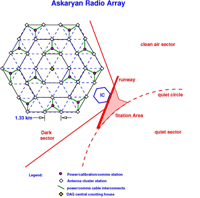Kara Hoffman, a professor in our particle astrophysics group, has recently been awarded a Major Research Instrumentation-Recovery and Reinvestment (MRI-R2) grant from the National Science Foundation (NSF). MRI grants are for funding the purchase or development of new scientific instrumentation, and this special solicitation, funded through the Recovery and Reinvestment Act, allowed for larger and more expensive initiatives to be considered. Hoffman received $1,477,750 in NSF funding for her proposal entitled "Collaborative Research: MRI-R2 Instrument Development of the Askaryan Radio Array, a Large-scale Radio Cherenkov Detector at the South Pole".
The Askaryan Radio Array (ARA), when realized, will be comprised of radio frequency antennas embedded in 200 m deep boreholes in the South Polar ice cap, encompassing an area of 80 square kilometers. These antennas will be used to monitor the ice for radio frequency impulses which occur when ultra high energy particles called neutrinos are captured in the ice. The very cold ice at the South Pole, which averages 2 miles in depth and temperatures of -60 degrees Fahrenheit near its surface, is extremely transparent to radio frequency emissions, allowing neutrinos interactions to be detected by antennas from several miles away. Neutrinos are interesting because they are fundamental particles that travel through the Universe unimpeded since they have virtually no mass and experience only weak interactions with matter. Some of them may propagate from their origin for billions of years, allowing them to form images of how the Universe may have appeared in the very distant past. They may also carry information about the cataclysmic processes at the dense cores of the astrophysical objects in which they are born. Neutrinos may also shed light on the enigmatic cosmic rays which constantly bombard our Earth's atmosphere, and will also provide a sensitive probe of particle physics and quantum gravity.
Prof. Hoffman's collaborators at the University of Wisconsin simultaneously submitted a linked collaborative proposal, for which they were awarded $1,317,885. These NSF grants, together with required contributions from their institutions, as well as foreign collaborators, gives them a total of 4 million dollars for the first phase of the project, which will span three years. They will commence construction at the South Pole in the coming austral summer, and Professor Hoffman expects to travel to the South Pole for the construction. She has previously visited the South Pole to work on her other project, IceCube, which is also a "neutrino telescope", but it uses light to detect neutrinos rather than radio waves.
